Everything You Need to Know About Math
You may accept noticed that there are new infill patterns in our new version of PrusaSlicer (two.3). Now, with the sheer corporeality of options, you might even feel overwhelmed with all the possibilities. Which infill should you choose? Is in that location a single universal pattern that works for every model? Or should you selection depending on a specific example? Let's take a await at what can be achieved past using the right kind of infill and adjusting its parameters.
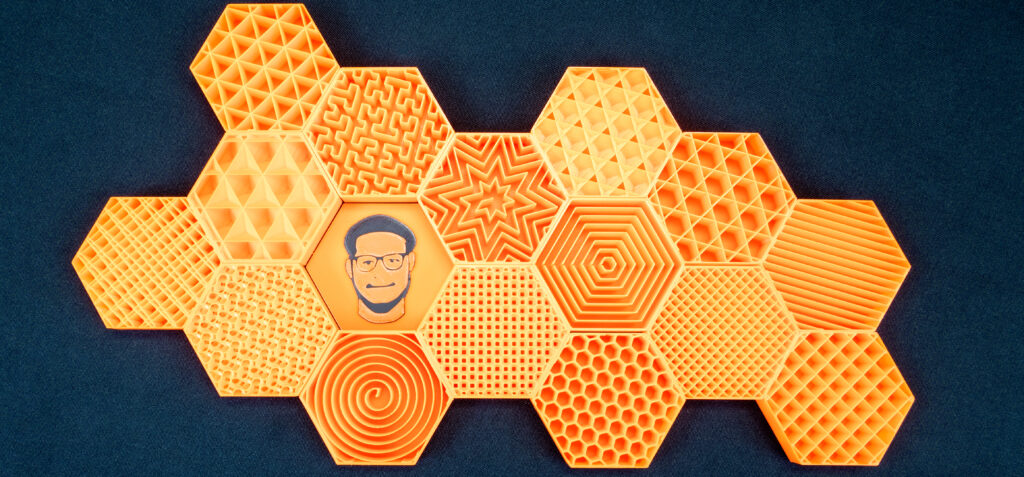
Infill: inner structure of your 3D prints
First, let's do a quick recap of what an infill is and why it is important. If you are a 3D-printing pro, you may desire to skip this chapter, just it never hurts to castor up on the basics, right?
3D printed models are rarely printed solid (100% infill) or completely hollow. Instead, we use a method that fills the inside of an object with a thin supporting structure. Infill provides internal support for meridian layers, which would otherwise have to span over empty infinite. This helps keep the model solid and prevents gaps and holes from actualization on the object's height surfaces. Solid models (100% infill) consume large amounts of filament and time. Also, in most cases, solid models won't provide meliorate mechanical properties compared to models with a sparser infill. If you determine to print a model without an infill, yous're risking that the surface of angled walls and top layers will be compromised – there might be small gaps or even large holes. It'due south pretty much obvious that the best solution lies somewhere in betwixt. With proper infill settings, you lot tin save a lot of material and time but also create some interesting patterns on the surface.
Most of the fourth dimension, it makes very picayune sense to set the infill density higher than 40 %. Our testing revealed that the best density setting is x-twenty%, and we implemented this value in our PrusaSlicer profiles. 10-20% is the ideal balance between force, print reliability, print time, and material consumption. Of grade, for some objects, a 5% (or lower) infill might be enough, particularly big elementary parts printed with PLA. With density higher than xx% comes higher tenacity. However, the same effect can be achieved by adding more perimeters too (Impress settings/Layers and perimeters). With unlike print settings, you can modify not only the internal structure and mechanical properties but also print speed, material consumption and the object'southward surface.
Before we start with advanced settings, permit'south take a quick wait at all available types of infills and their properties i by i.
Infill types and their backdrop
The list of infills has grown a lot and information technology might be difficult to choose the right type. Although you lot may feel they differ more often than not in appearance, the opposite is truthful. For instance, some infills may relieve us a lot of textile and fourth dimension, some tin can be filled with liquid, etc.
Rectilinear
Rectilinear is one of the basic infill patterns. Information technology creates a rectilinear grid by printing one layer in ane direction, the next layer rotated by xc°, etc. This way, it saves filament and doesn't accumulate material at crossings (unlike filigree). Information technology'south one of the fastest printed infills.
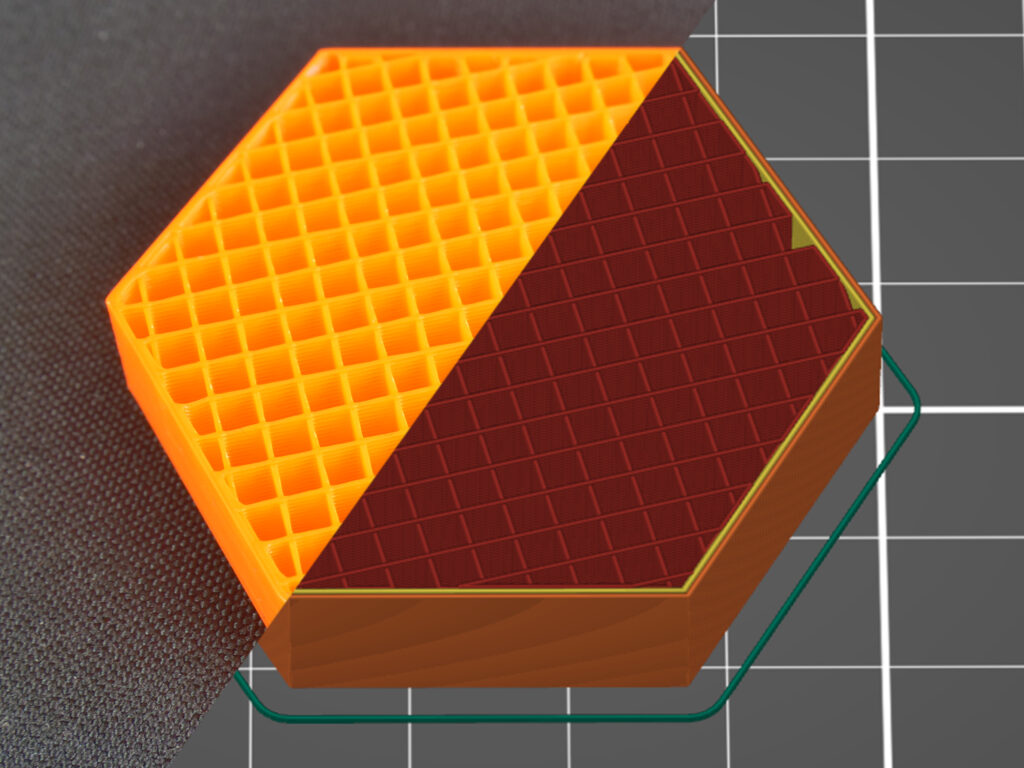
This blazon of infill is the but 1 recommended for 100% infill printing. If you have another type of infill set in your profile and change the infill pct to 100% density, PrusaSlicer will automatically modify the infill type to rectilinear.
Aligned rectilinear
This infill is formed past parallel lines drawn within the model, which resemble the exterior support structures. Similar to the previous type, this infill saves time, has average material consumption, plus information technology doesn't accumulate fabric at crossings. All the same, using this infill might cause some trouble when the management of the lines in the infill is the same as in the infill of the beginning top solid layer – if they are perfectly parallel, the acme layers might have issues with bridging.
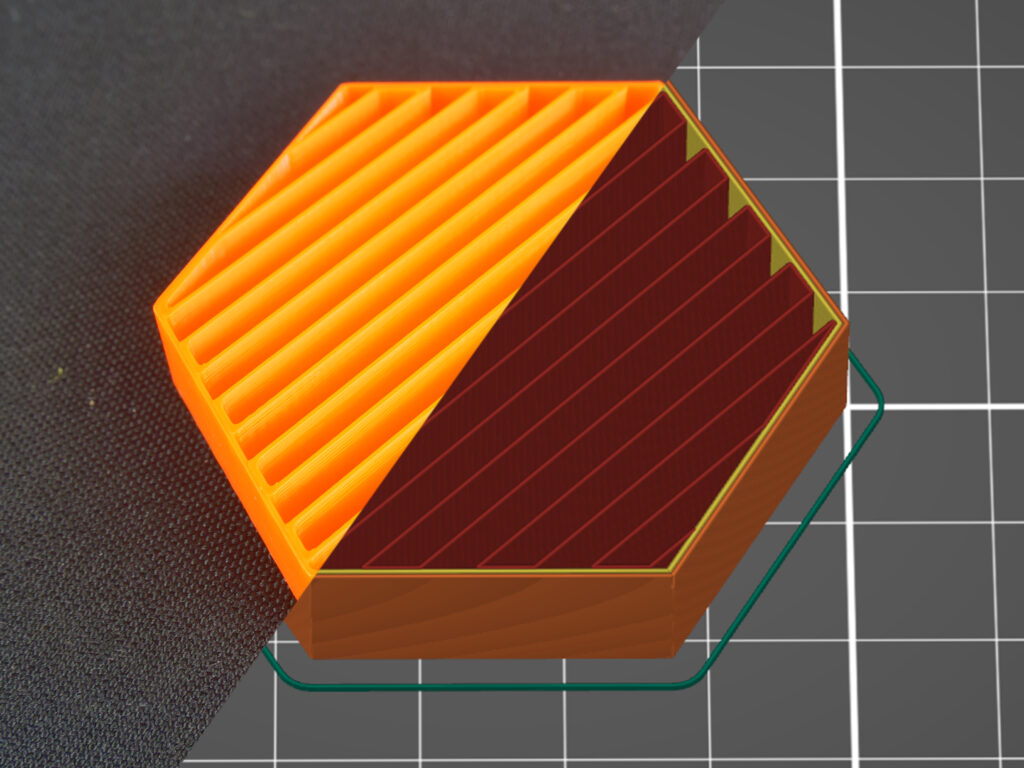
Filigree
This is one of the simplest and fastest variants of infill. Different rectilinear, information technology'due south printed in both directions (rotated by xc°) in each layer. This way, material accumulates in spots where the paths cantankerous. The filigree infill is more than solid (and has better layer adhesion) than the rectilinear infill, however, it sometimes can cause annoying noise or fifty-fifty a print failure due to the nozzle going over the crossings where fabric accumulates.
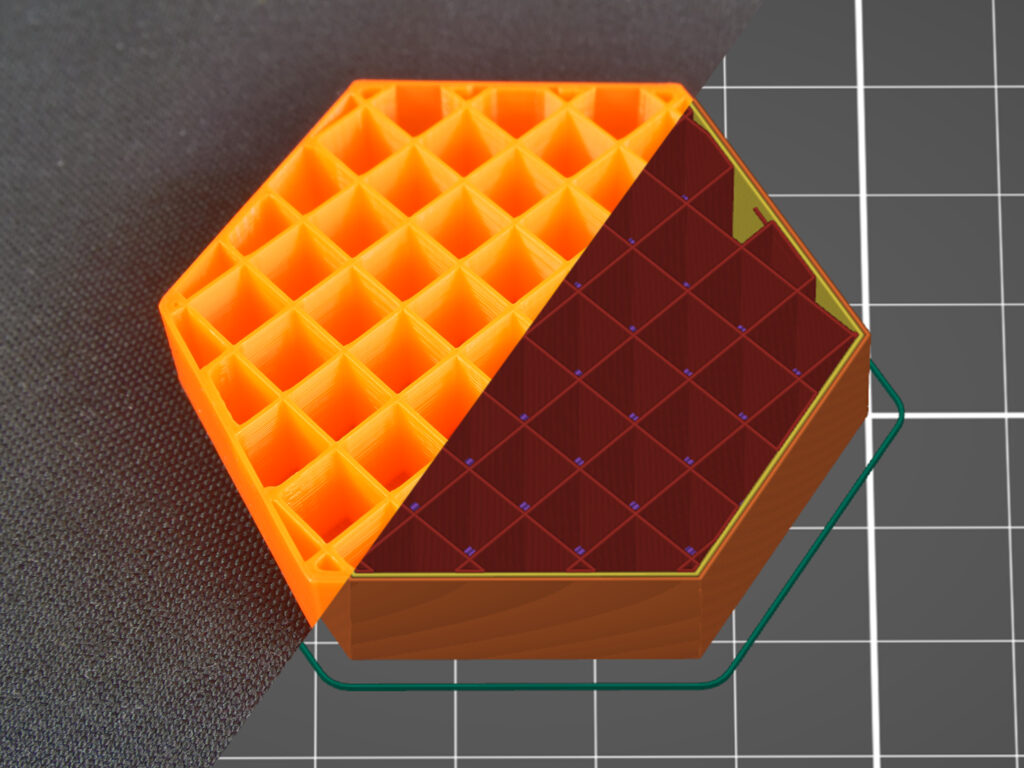
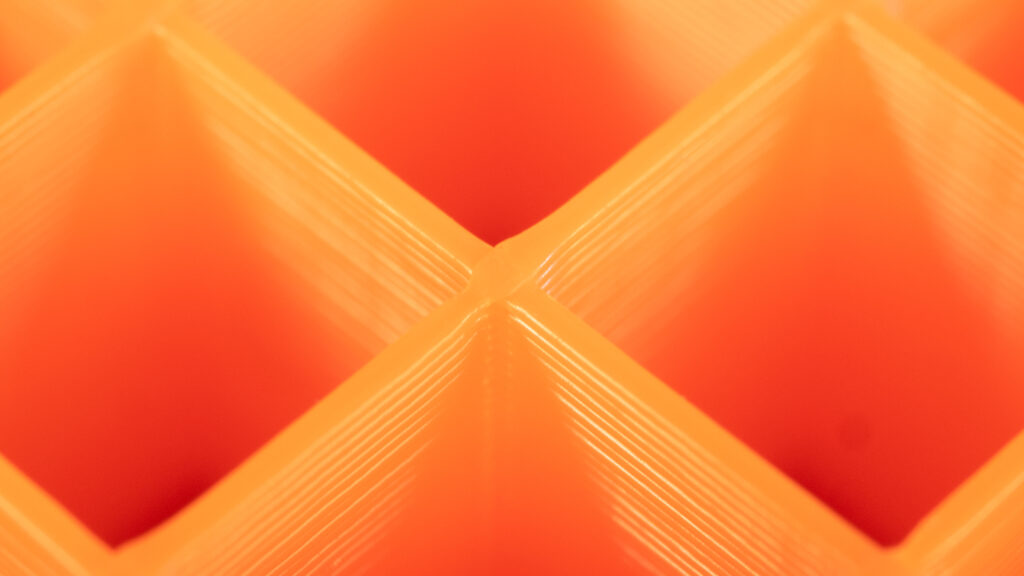
Due to the way this infill is printed, the paths cantankerous and cause the material to accrue in these spots. You lot may hear a specific noise as the nozzle hits these parts. This may even lead to a failed print.
Triangles
This infill works similarly to the grid infill – the paths cross in one layer, even so, this time they are printed in iii directions and grade a triangle structure. Textile and time consumption is almost identical to the grid.
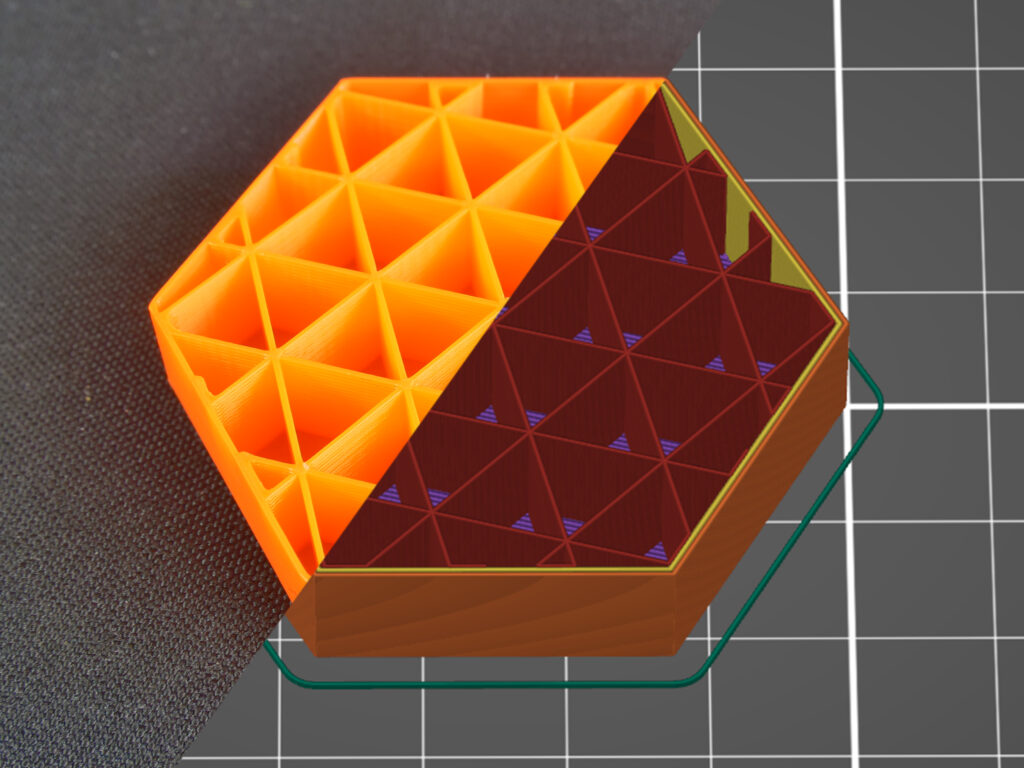
Stars
The Stars infill is based on triangles but paths are shifted to make six-pointed stars. Again, this infill is created by lines that cantankerous each other inside a single layer. Material and time consumption is similar to the previous infill.
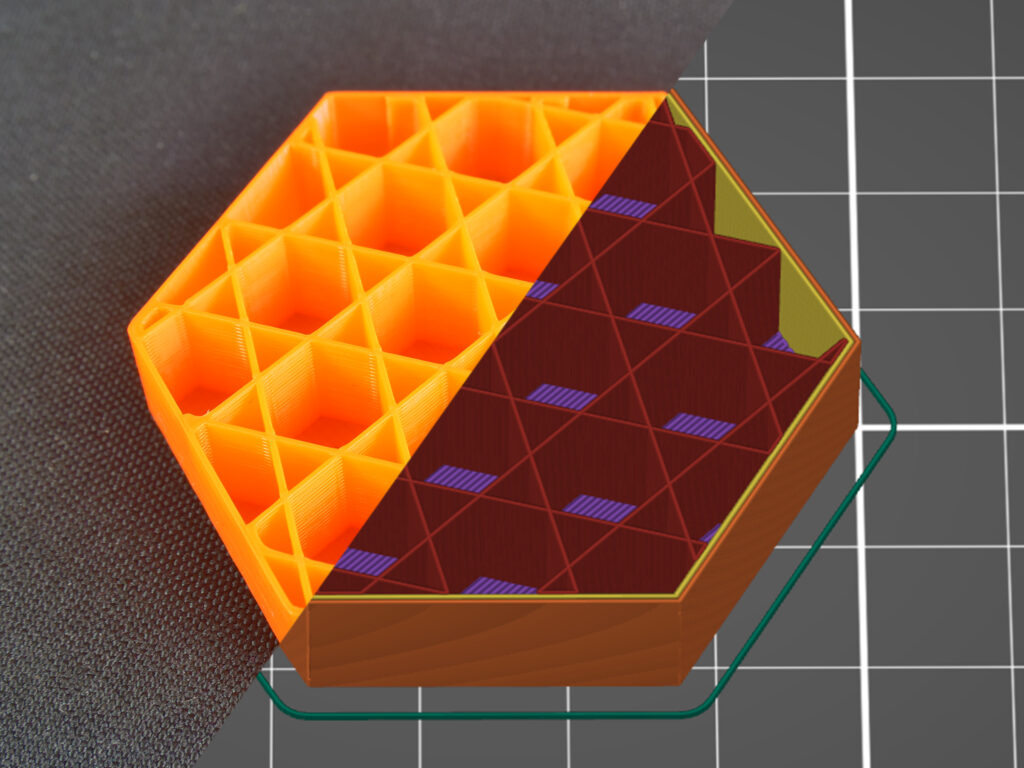
Cubic
Once more, this is an infill with paths that cantankerous each other within one layer. However, unlike previously described infills, it creates cubes oriented with one corner facing down. This way it makes numerous air pockets that might serve equally heat insulation, or crusade the object to float on water (with waterproof filaments such every bit PETG). Print time and filament consumption does non differ from the previous infills.
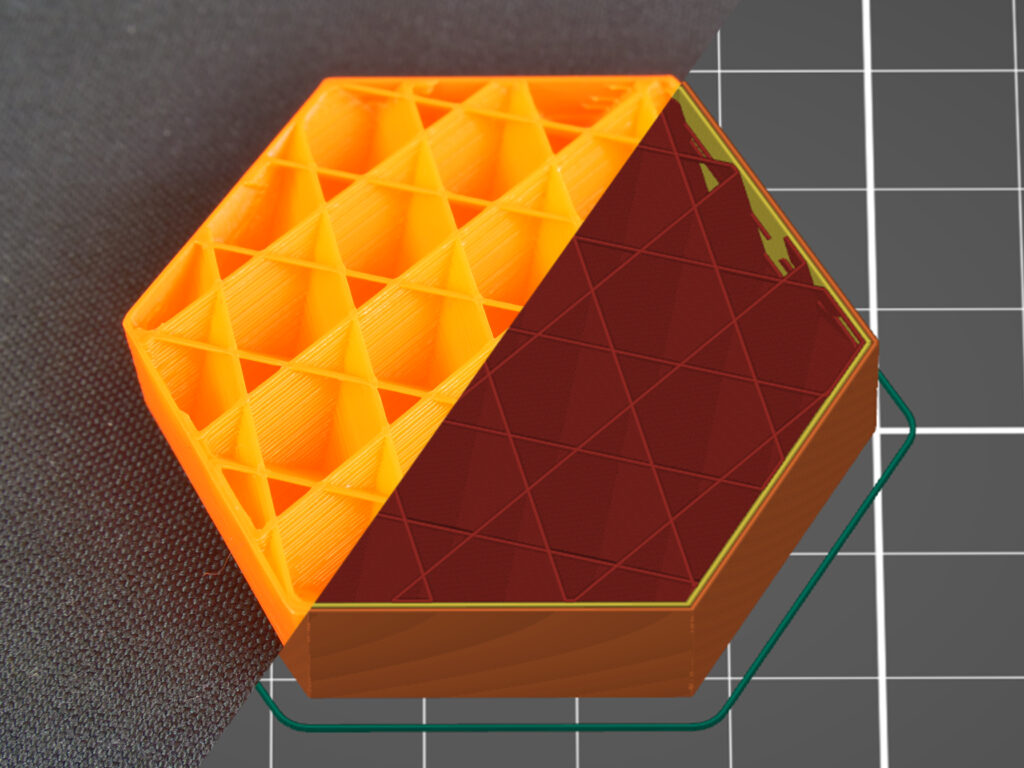
Line
The Line is one of the infills that don't feature any crossing paths in 1 layer. Its paths are similar to the rectilinear infill but they are non parallel to each other. Instead, they are printed at an acute angle. Unsurprisingly, this infill is similar to rectilinear when it comes to press time and material consumption.
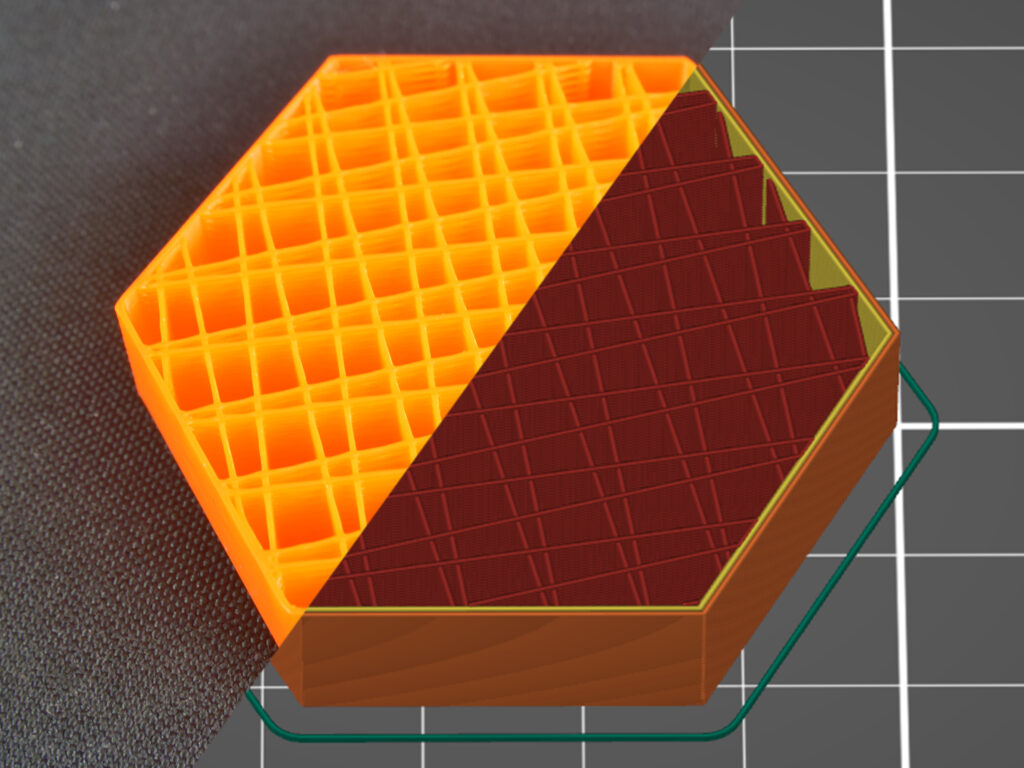
Concentric
The concentric infill traces the model perimeter lines and makes them smaller towards the eye. In other words: if yous print a cylinder, the concentric infill will create concentric circles within that cylinder. This can be useful with transparent parts or flexible models (RC tires for example). The principal disadvantage is the time spent press. Material consumption is not higher than previous types of infill patterns.
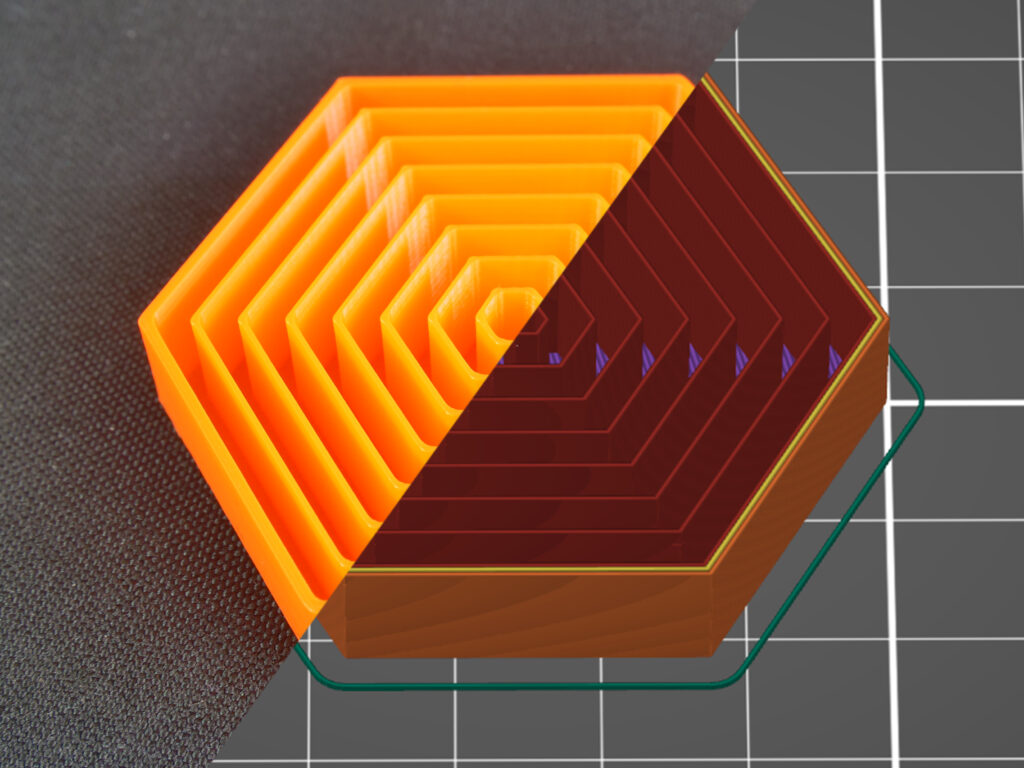
Honeycomb
This infill prints a grid made of hexagons. Its main advantage is mechanical resistance and optimal paths without crossings. The chief disadvantages are college cloth consumption (approx. 25% more) compared to other infills, and print time that tin can take up to twice the time of previously described options.
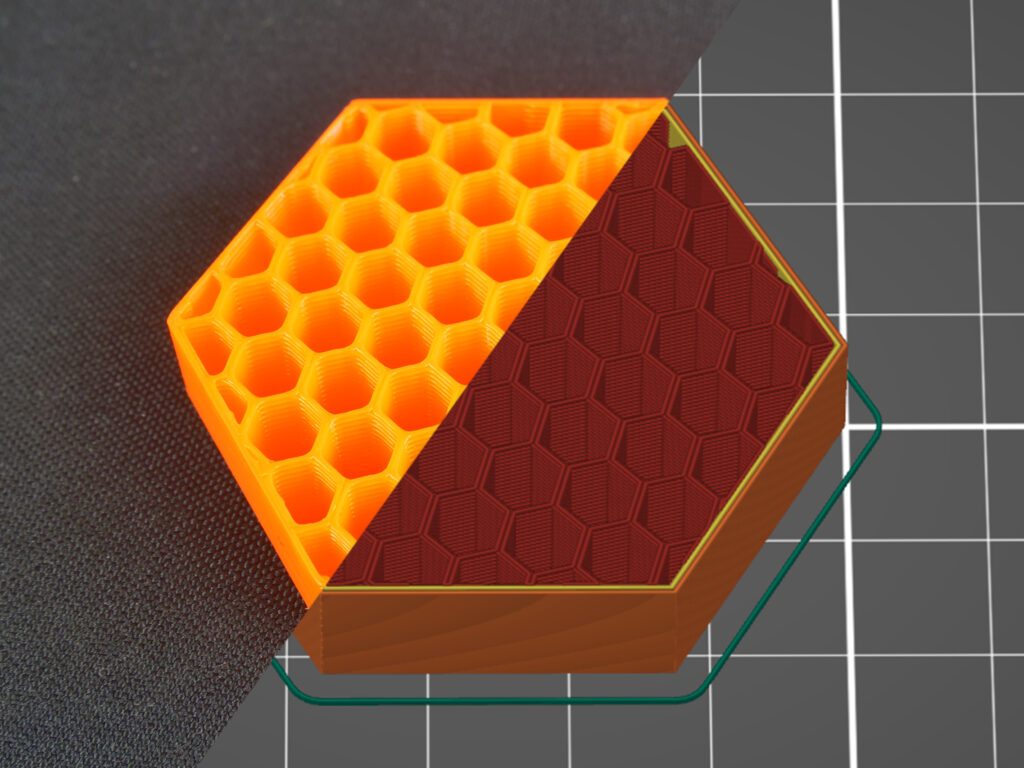
3D honeycomb
3D honeycomb prints bigger and smaller squares and octagons to create columns of periodically increasing and decreasing thickness. Again, this infill doesn't take crossing lines in i layer, nonetheless, due to the way it lays down the paths, it creates small-scale gaps betwixt layers. Material consumption and impress fourth dimension are slightly worse compared to the regular honeycomb pattern.
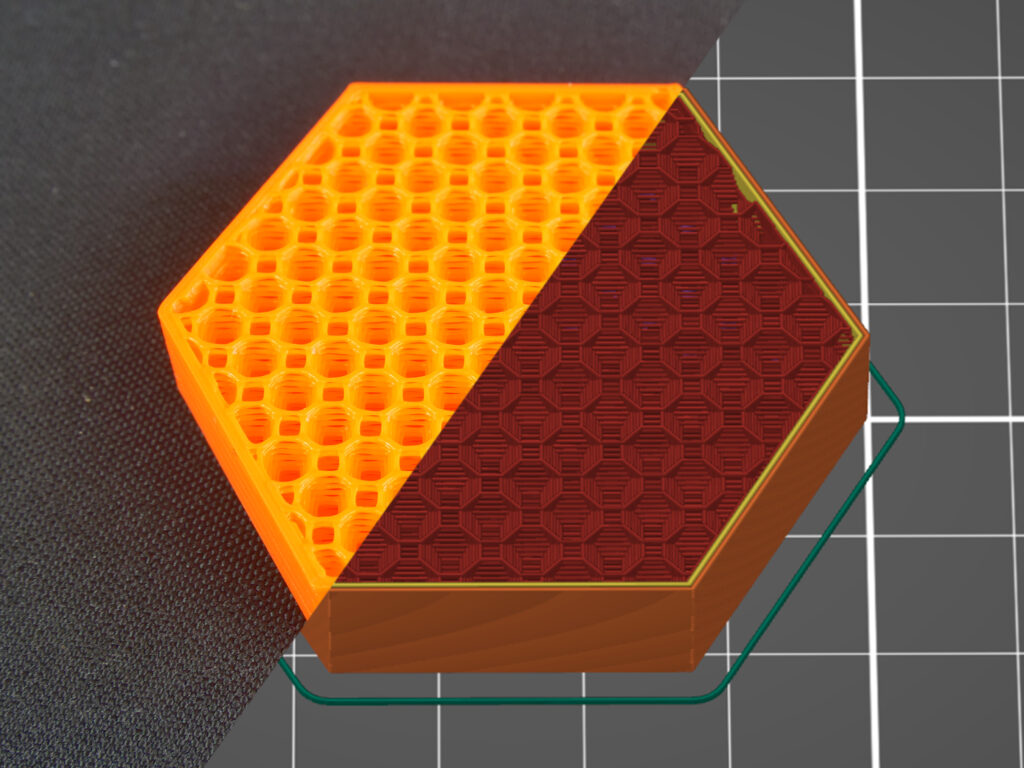
Gyroid
The Gyroid is our favorite and one of the best infills. It's i of the few 3D structures that provide keen support in every direction. Plus it's printed relatively fast, saves material, doesn't have crossing lines in i layer and looks great. The special shape of this infill allows filling it with epoxy resin or another liquid.
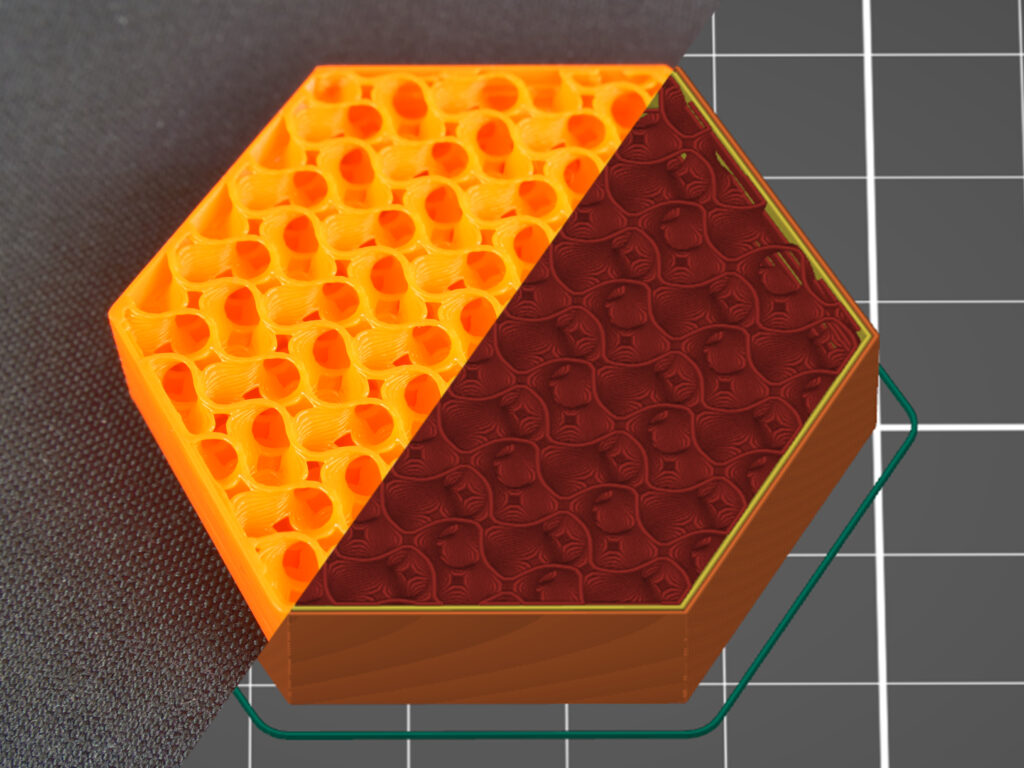
Hilbert curve
The Hilbert curve creates a rectangular labyrinth within the model. The main advantage of this infill is its not-traditional look, plus it tin be pretty easily filled with epoxy resin or another liquid – the model is split into several large cavities, instead of a number of small-scale "bubbles". The main disadvantage of this infill is increased impress time, which sits somewhere between honeycomb and rectilinear infills. The material consumption of the Hilbert bend is similar to the rectilinear.
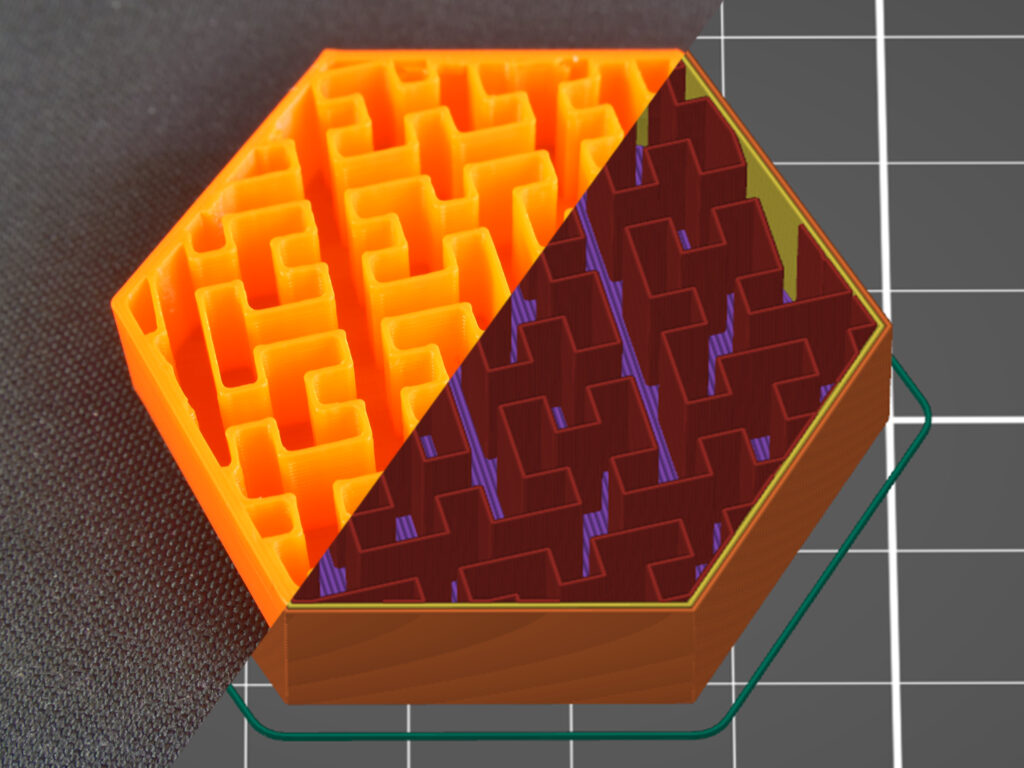
Archimedean chords
Again, this spiral-twisted infill allows easier filling with liquid. This simple shape saves material and fourth dimension (compared to the rectilinear infill). Similar to the concentric infill, the Archimedean chords help with model flexibility if you print information technology with flexible filament.
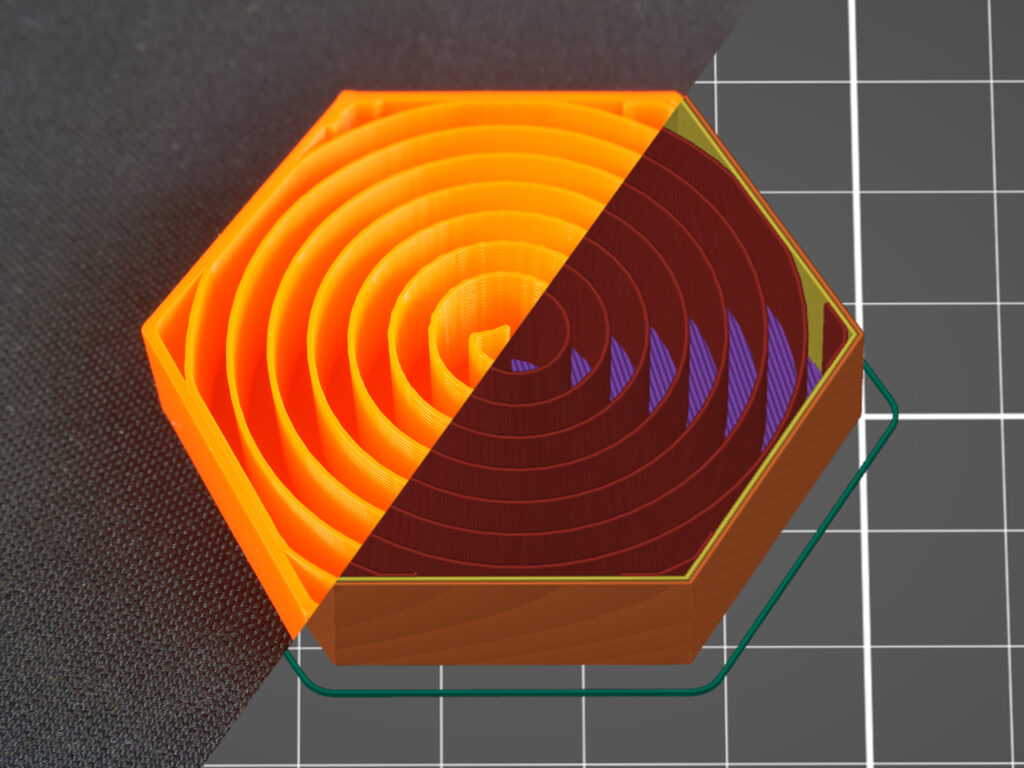
Octagram spiral
Octagram spiral allows filling the object with liquid easily due to larger compartments made with this type of infill. An Octagram screw might also help with flexibility for certain models. Just generally it'southward for aesthetic purposes and top layer support. Textile consumption is like to Archimedean chords just print time is slightly longer.
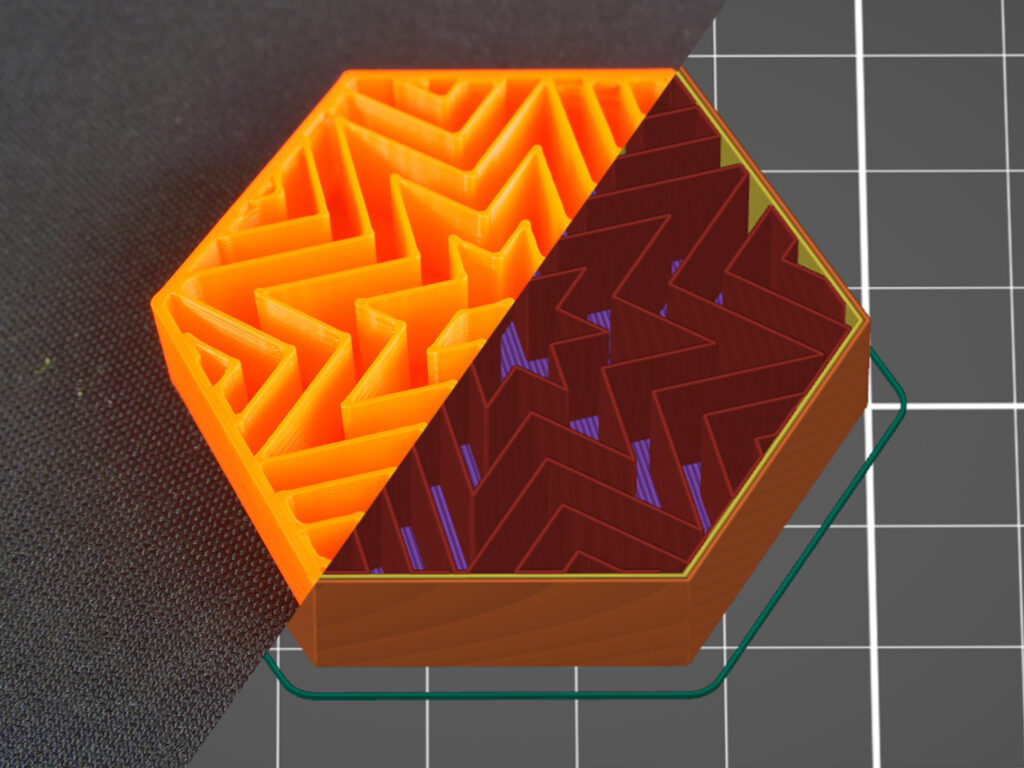
Adaptive cubic
The adaptive cubic infill works on the same principle equally cubic: It consists of cubes oriented corner-down where lines cross themselves in one layer. Just there'southward 1 great advantage: Dissimilar a simple cubic infill, this blueprint makes the infill denser towards the model edges, leaving large cavities in the middle. Fabric consumption is approx. ¼ less than the rectilinear infill.
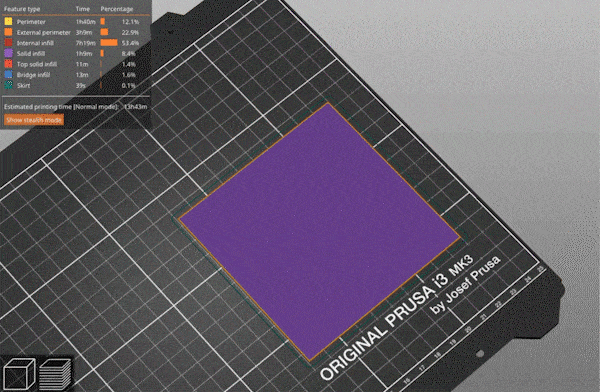
The Adaptive Cubic infill works by refining those cells of an octree, that contain any object triangle. Anchors are added to each infill line. This makes the infill sturdier and information technology stabilizes the extrusion period at the start of an infill line. Basically, This infill gets automatically more or less dumbo, depending on the distance to the nearest wall. This is peculiarly useful for big prints with a large internal volume. The result is shorter print fourth dimension and lower filament consumption while maintaining nifty support for meridian layers and similar mechanical properties.
Back up cubic
The back up cubic infill works similarly to the previous blazon but with one difference: the infill density increases only in the Z-axis. Its primary function is to support acme layers by saving as much material every bit possible, information technology doesn't ameliorate any mechanical qualities of the model. Material consumption and print time of this infill are by far the lowest of all the supported infills.

Types of peak (bottom) layer infill
Editing infill doesn't terminate with choosing an infill type for the internal parts of the object. You can also change top and bottom layer infill types to get some interesting results. These tin can be adjusted in the Print settings/Infill/Tiptop (Bottom) make full pattern tab. However, changing the top or bottom infill mostly affects the aesthetic changes and does not improve the mechanical properties of the model.
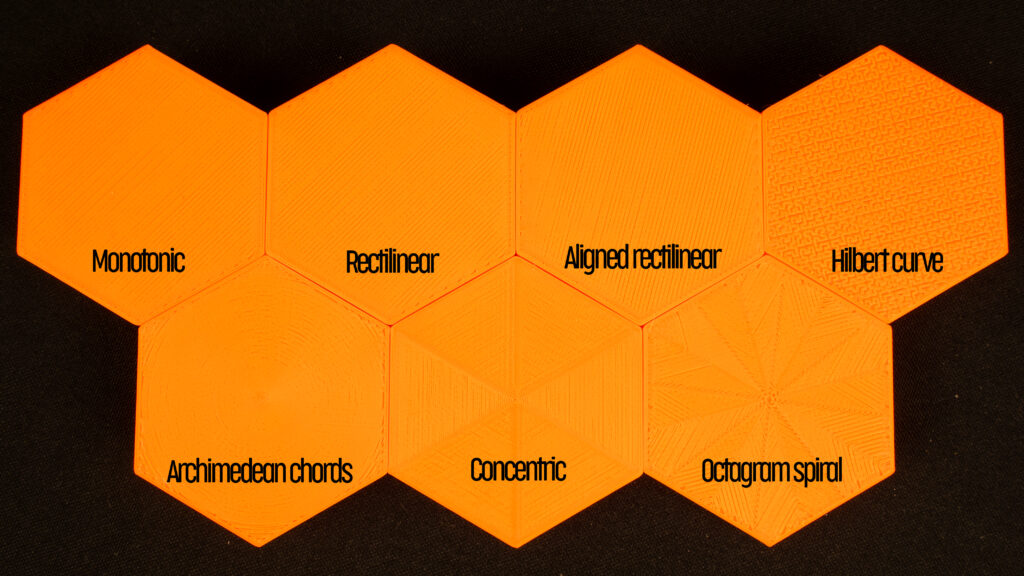
All seven types of the top (lesser) infills printed with 80% menstruation to highlight the patterns.
Rectilinear
Over again, this is one of the about common (and basic) types of top infill. The impress paths are oriented zig-zag for the whole layer. However, this is the simplest type of infill that doesn't provide any advantage whatsoever (run into Monotonic infill).
Monotonic
The monotonic infill blueprint fills the top (bottom) layer with parallel lines, similar to the rectilinear infill type. However, this infill works with avant-garde path planning. Unlike rectilinear, this infill is ever printed left to correct and never in the opposite direction. This uncomplicated organisation leads to achieving a homogenous infill without ugly ridges. These usually appear with other infills when left to right paths come across the right to left ones. This seemingly uncomplicated method is surprisingly hard to implement. Nosotros used the Ant Colony Organization variant described by Raad Salman.
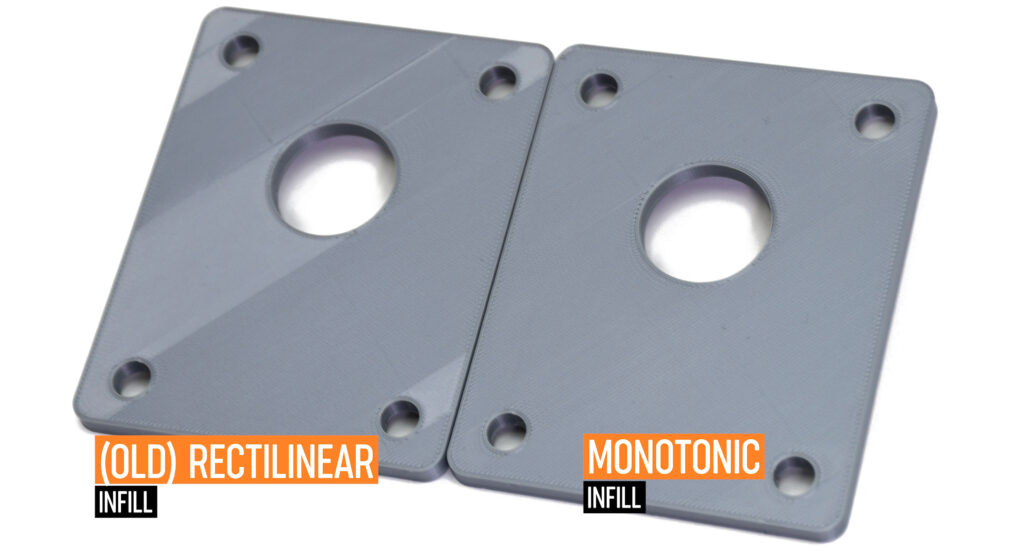
Aligned rectilinear
This infill pattern works similarly to the rectilinear infill but the last layers on all top surfaces are aligned in the same direction. This can help for creating a homogenous top layer pattern for models that have top layers in different heights (imagine a staircase model).
Concentric
The concentric infill pattern copies perimeter shapes. If y'all print a cylinder, information technology will create concentric circles on superlative of the model.
Hilbert curve
This is mostly an aesthetic infill. If information technology'south printed inside, Hilbert Curve creates rectangular shapes, while the topmost layer looks more similar a wicker handbasket. Some people say that it looks "wormy". This infill significantly increases the print time due to the complex shape.
Archimedean chords
The topmost layer of archimedean chords is printed in a spiral. This infill can save time when printing certain models.
Octagram spiral
Over again, this infill is described above. It's proficient mainly for aesthetic purposes but due to the complex shape, information technology prolongs the print time.
Advanced settings
PrusaSlicer lets you suit infill patterns even more than! If you switch to the Avant-garde or Expert way, you'll notice a lot more than settings in the Infill tab. Permit's take a look at all the settings related to infills, regardless of whether information technology'south in Avant-garde or Expert style:
Length of the infill anchor
The infill is usually connected to the perimeters with a so-called anchor, which is a short line of another (inner) perimeter that turns into an infill line. The length of the infill ballast value sets how many millimeters of this anchor will connect the infill and the perimeters. If you set this value to 0, the infill volition be printed independently on the perimeters. Ready a college value to print the anchor that will continue equally the infill itself. The infill anchor helps to increment model integrity and toughness.
The maximum length of the infill ballast
This value sets the maximum length of the infill anchor connecting the infill with perimeters.
Ironing
Ironing creates a smooth summit surface on horizontal planes – filament paths are almost invisible. How is this accomplished? The hot nozzle goes over the surface one more fourth dimension merely with low filament flow. Turning the ironing on or off, and/or choosing the ironing type (all meridian surfaces, topmost surface but, all solid surfaces) should be plenty for most 3D printer users. However, some may want to tweak the period rate or spacing between ironing passes. The flow rate is fix every bit a percentage linked to the normal layer height, the spacing between ironing passes tells how far the parallel nozzle tracks should be from each other. These parameter values are ready to optimal values, but you can experiment with them as you wish if you are non happy with the results.
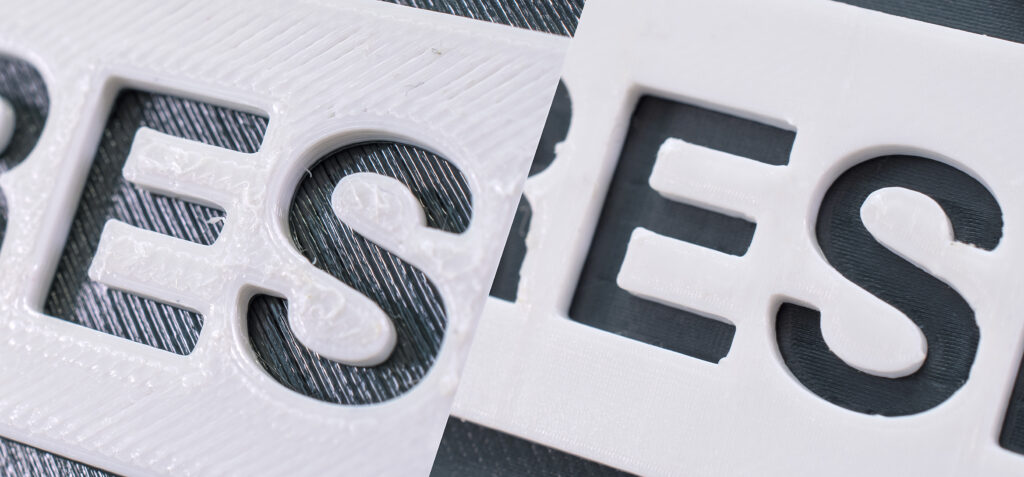
If you increase menstruation, you risk that material leftovers will remain on the surface. Also, the nozzle tracks may remain visible. Lower period, on the other hand, will leave the last layer paths visible due to a lack of fabric filling the gaps.
Spacing between ironing passes has a great influence on the meridian layer visibility likewise. To make it a bit easier to imagine, we'll compare information technology to a snowplow. Let'south say you use just a role of the plow blade to clean off the snowfall – information technology volition remove some amount of snow and make clean the plowed function of the route, as well. Notwithstanding, if you dig the entire plow bract into the snow and movement forward, you'll create a path, but there volition exist excess snow left backside.
To find out more about ironing, read our older article.
Reducing printing time
PrusaSlicer offers two variants of saving time and material. The first option is combining infill every Ten layers. The default value is set to i, where every perimeter layer is printed with one infill layer (one = ratio of i infill layer per one perimeter layer). Increasing the value to 2 (2:1 ratio) will print one layer of infill (of co-ordinate layer superlative) for every two perimeter layers. Merely go on in mind that this value cannot be increased infinitely. PrusaSlicer will let you set information technology very high but the only maximal physically possible value volition be written into Thou-code. To be specific: If y'all use a 0.4mm nozzle and 0.15mm layer height, the slicer won't let you lot print one infill layer less frequently than every two perimeter layers. Otherwise, the infill would exist printed to empty infinite. But if you print with 0.05mm layer top (0.4mm nozzle), you lot can combine infill every 6 layers (maximum layer height is 0.3mm).
The 2nd variant of saving fourth dimension (and material) is press infill but where needed. For example, if yous print a sphere, this part will make only an infill column in the heart to support possible overhangs. The primary disadvantage of this function is low denting resistance due to the lack of infill in some model parts.
Advanced
These infill settings are truly advanced stuff and most 3D printer users won't fifty-fifty come close to ever needing them. Notwithstanding, there might be some special cases when you'll need to adjust them, and then let'south take a look at what they do:
Printing solid infill every X layers tin can come in handy when you desire to increase the model'due south toughness (increasing the number of perimeters works ameliorate, though) or dividing it into multiple cavities that might be useful if y'all want the object to bladder on water. This function simply causes a solid infill to exist printed at regular intervals.
Make full angle rotates its blueprint past chosen bending.
Solid infill threshold area is useful mostly for tiny and complex parts. With this setting, you lot can adjust how big or pocket-sized cavities of the model should be filled with a 100% infill. This tin aid to make sparse parts stronger.
A bridging angle is calculated by PrusaSlicer automatically. If y'all get out it at 0°, PrusaSlicer will cull the best value. Notwithstanding, you lot can change information technology manually if y'all wish. Printing with a bridging angle equal to 0° can exist achieved past setting it to 180°.
Only retracting when crossing perimeters can reduce printing time a little and increase infill integrity. Turning retractions off will increment filament dripping that won't be visible (subconscious within model). Retractions volition remain turned on for perimeters.
Press Infill before perimeters might sometimes help with printing overhangs where perimeters have nothing to adhere to. However, infill might negatively impact the quality of the external surface. The second usage of this method is for MMU2s where wiping colors gets better results – the colour is cleaned to infill and the perimeter is printed with make clean color.
And this concludes our deep dive into the globe of infill patterns. Nosotros offer our own in-house tested PrusaSlicer profiles with tweaked values, which should work for a vast majority of users. However, if you experience like your prints are not 100% up to par, or you would like to experiment a picayune scrap, don't be afraid to suit the values. A good manner to compare your results is to print a set up of sample models and inspect how the adjusted values bear on the result. If you desire to step up your 3D press game, experimenting with infills is a recommended option – your models may become nicer, more durable, or you tin can even find brand new uses for them because some of the infills eastward.g. improve the floating capabilities of printed models. And then go ahead, have fun, and as always: Happy printing!
williamsstonarnined.blogspot.com
Source: https://blog.prusaprinters.org/everything-you-need-to-know-about-infills_43579/
0 Response to "Everything You Need to Know About Math"
Post a Comment